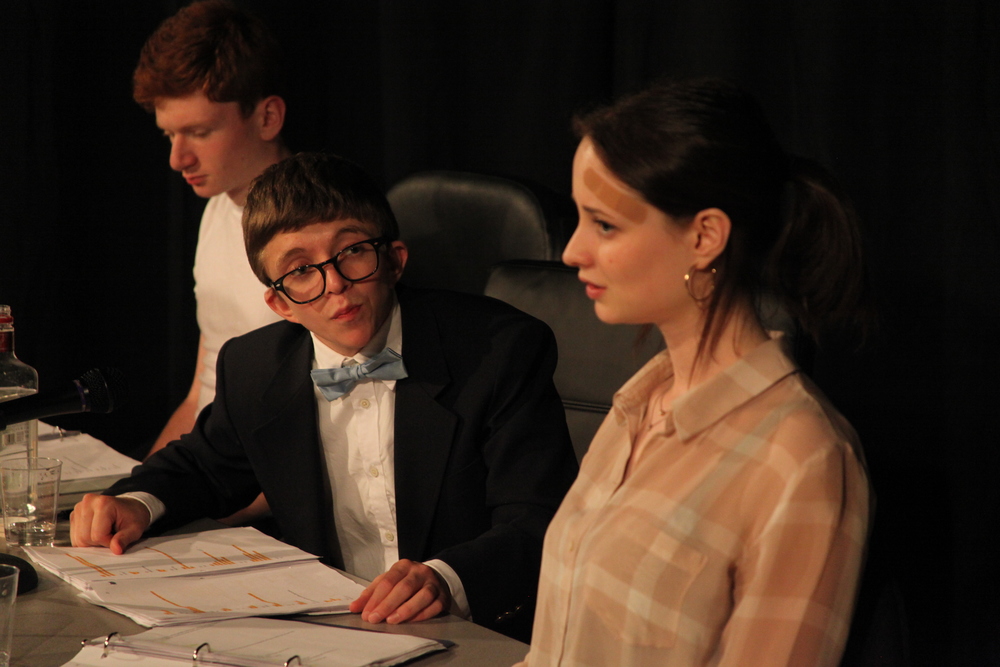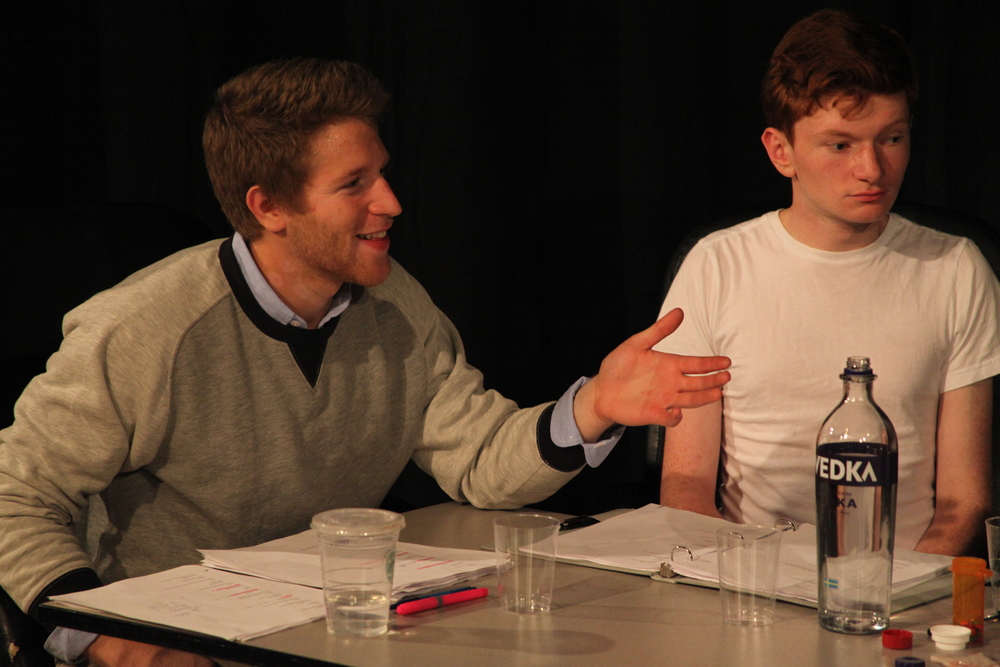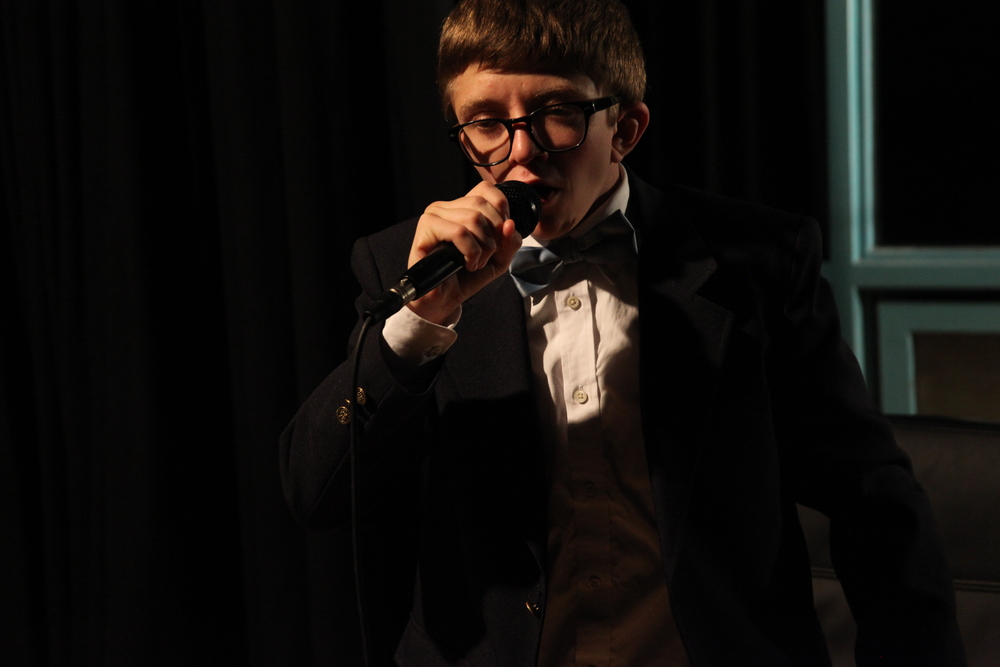
Zachary Cohn ’16, Henry Weis ’16, Julia Friedland ’17
Cut To: Walt…Pauses
By: Ryan Crotty
Walking into the space of A Public Reading of an Unproduced Screenplay About the Death of Walt Disney, it is easy to imagine you are about to see a conventional and linear production. The chairs were arranged interestingly, a minimal stage was set with four chairs, and Disney music played in the background. Once you took your seat, however, it became clear that this show was anything but typical. The music became distorted and disjointed, often playing backwards—the effect of which was both troubling and sentimental. As the seats began to fill, the cast entered, staggered by five to ten minute intervals. All entered, regarded the audience with either passivity or curiosity, and took their seats, usually not interacting with the audience again. The wardrobe was not outlandish, mostly up-class street clothes, though each character was barefoot and had blue nail and toe polish on. Finally, when the audience had all taken their seats, Walt (Henry Weis ’16) entered, and the lights went down.
Directed by Kevin Berry ’15 and stage managed by Robin Miller ’16, Lucas Hnath’s A Public Reading of an Unproduced Screenplay About the Death of Walt Disney tells the story of a man who claims to be Walt Disney in the final years of his life and his struggle to qualify his legacy. He is joined by his brother, Roy (Julia Friedland ’18), his daughter (Zachary Cohn ’16), and his son-in-law (Noah Kernis ’15), who all have various roles to play in the telling of this story. We see the stress of being an American icon eat away at the sanity of Walt, as he alienates his family to an even greater degree and takes comfort as he reminisces on those who have seen and loved his work. Roy takes the hardest hits from his brother, as Walt publicly condemns him for a filming mistake and encourages his son-in-law to undercut Roy to “the board.” However, we do see the value Roy holds for Walt, as he is usually the only one who is honest and critical to Walt, while at the same time expressing his own love and care.
We are given a look at the toll Walt has taken on his family as well, several conversations with his daughter show us that absence and neglect has left her with a profound sense of sadness, of which Walt is hesitant to admit being the cause. We also witness a phone conversation with Walt’s spouse; the conversation is short, choppy, and sad. Walt only refers to her as “Wife,” and we see a moment of humanity as he discusses his fear of death, and asks if she would join him in being cryogenically frozen.

Noah Kernis ’15 and Zachary Cohn ’16
Walt’s son-in-law is shown as someone who idolizes him and is presented as a classically dumb jock—someone who Walt hates. This admiration is also something that Walt has to come to terms with, as he lists all the famous people he knows who were fans of his. In the end, we are shown the final death and freezing of Walt, left only with his brother in the end. The final moments of Berry’s production were marked with technically impressive and aesthetically interesting lighting and sound (both designed by Berry), which culminated in a sudden darkness that left the audience with a feeling of sense deprivation.
If there is one thing that set this production apart from many others presented at Skidmore in recent years, it is the Hnath’s text. The actors were mostly off-book, meaning that some of the lines were read from the script—to give it the feeling of a reading—and some were memorized. Walt addressed the audience in some scenes, while in others he primarily interacted with the other actors. Occasionally, Walt would tell us the “stage direction” in a short, direct manner into a microphone. This sudden transition in tone, as well as volume, was startling toward the beginning of the performance, though it became almost natural by the end.
While the pace was often quick and peppered with Walt’s whit, the sudden pauses in speech often said just as much as the spoken text. In the show, we are also treated to a glimpse inside director Kevin Berry’s mind. From casting decisions to the actual set, Berry made many strong choices that truly made the performance his own. Throughout his process, he allowed his actors to influence the show as well. In his words, “it became necessary to let the play transcend itself from a strange staged reading into something much, much more.” This mindset, as well as the wonderful casting choices and evocative lighting and stage design, made for a production that reminds us of the rewarding experience such wonderfully unconventional theater can provide for both performers and audience.

Henry Weis ’16
This article originally appeared in print in the Fall 2014 Skidmore Theater Newsletter.
